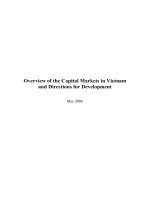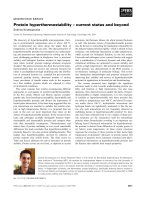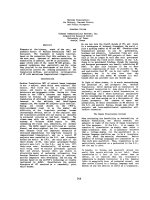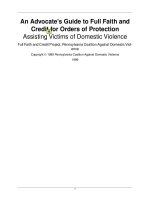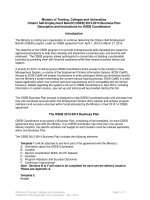Brazil''''s Capital Market: Current Status and Issues for Further Development pot
Bạn đang xem bản rút gọn của tài liệu. Xem và tải ngay bản đầy đủ của tài liệu tại đây (1.63 MB, 21 trang )
Brazil's Capital Market: Current Status and
Issues for Further Development
Joonkyu Park
WP/12/224
© 2012 International Monetary Fund WP/12/224
IMF Working Paper
Western Hemisphere Department
Brazil’s Capital Market: Current Status and Issues for Further Development
Prepared by Joonkyu Park*
Authorized for distribution by Vikram Haksar
September 2012
Abstract
Capital market development in Brazil is a key policy issue going forward to foster savings,
investment and absorptive capacity in a context of prospects for sizable capital flows in the
medium term. During the last decade, Brazil has achieved substantial progress in capital
market development. The menu of available financial instruments has been expanded, market
infrastructure has been reformed and strengthened, and a diversified investor base has been
built. Nonetheless, Brazil’s capital markets are still facing a number of challenges including
prevalent short-term indexation, investors’ risk aversion to long-term fixed rate bonds, still
low liquidity in the secondary market, and managing the role of BNDES. A shift to a lower
yield curve environment should continue to gradually take place. But further progress will
require continued policy effort to assure macro stability and financial sector reforms to
promote the development of longer-term private finance.
JEL Classification Numbers: E44, G15, G28, G32
Keywords: Brazil, capital market, indexation, long-term financing, BNDES
Author’s E-Mail Address:
*The author wishes to thank Vikram Haksar, David Vegara as well as the Brazilian authorities, for their insightful
comments.
This Working Paper should not be reported as representing the views of the IMF.
The views expressed in this Working Paper are those of the author(s) and do not necessarily
represent those of the IMF or IMF policy. Working Papers describe research in progress by the
author(s) and are published to elicit comments and to further debate.
2
Contents Page
I. Introduction 3
II. Brazil’s Capital Markets—Issues and Status 3
A. Short-Term Maturity and Low Turnover 3
B. Equity Market 4
C. Government Bond Market 8
D. Private Bond Market 10
E. Role of BNDES 13
III. Key Policy Challenges and Options 14
A. Issuers’ Side: Enhance Supply and Attractiveness of Long-Term Instruments 14
B. Investors’ Side: Boost Potential in Mutual Funds 15
C. Changes in the Role of BNDES 17
IV. Conclusions 18
References 20
Figures
1. Variables Related to Short-Term Duration and Low Turnover 4
2. Recent Developments in Equity Market 5
3. Peer Comparison of Equity Market 5
4. Industrial Composition of Stock Exchanges 6
5. Investor Composition in IPO and Stock Trading 7
6. Foreign Investors’ Share in Market Capitalization 7
7. Profile of Government Bonds 8
8. Average Maturity of Government Bonds 9
9. Investor Base for Fixed Rate Bonds 9
10. Each Investor Group’s Preference on Government Bonds (As of April 2012) 10
11. Private Bond Issuance and Investor Composition 11
12. Corporate Financing during the Crisis: Brazil 12
13. Corporate Bond Market During the Crisis: Korea and Chile 12
14. Investor Base in Corporate Bond Market: Korea and Chile 13
15. Recent Developments in BNDES 13
16. Peer Comparison of Mutual Fund Industry 16
17. Changes in Asset Allocation of Mutual Fund Industry 16
18. Mutual Fund’s Sensitivities to Changes in Interest Rate 17
19. BNDES Disbursement by Sectors and Types of Operations 18
20. Design of Capital Market Development 19
3
I. INTRODUCTION
Financial development is important for fostering economic growth and stability. This is a
feature of the development process that has been extensively documented in the literatures
(see Levine).
1
Capital market development in Brazil is a key policy issue going forward to foster savings,
investment and absorptive capacity in a context of prospects for sizable capital flows in the
medium term. Brazil’s savings and investment levels as a share of GDP are still low by
international standards. As such, deepening capital markets would be important for
increasing incentives for savings and allocating these efficiently to investments. Deep and
liquid capital markets could also help bolster resilience to capital flows by developing greater
absorptive capacity.
One of key components in this process is capital market development. For
example, deepening the long-term local bond market facilitates the reduction of currency and
maturity mismatches on corporations’ balance sheets. This also creates alternatives to bank
financing that can support efficiency and stability. From investors’ point of view, deep and
liquid capital markets increase the supply of differentiated assets facilitating investment
choices. Perhaps most importantly for emerging markets (EMs), the macroeconomic and
financial dislocations experienced following the crises in the late 1990s have led to increased
efforts in these countries to develop local capital markets.
This paper reviews the state of play in Brazil and steps for further development. It starts by
taking stock of the current status of local capital markets in Brazil, including in terms of size,
investor base, maturity structure, both for the public and private sector. It then discusses what
the key challenges are, and policy options for further development.
II. BRAZIL’S CAPITAL MARKETS—ISSUES AND STATUS
A. Short-Term Maturity and Low Turnover
Brazil’s capital market remains focused on short term instruments. Most financial contracts
among residents are indexed to the overnight interest rate, although there has been a gradual
trend towards increasing duration in the recent years. This largely short term structure
reflects long-standing fundamental factors, including a legacy of past high inflation that
typically is associated with a more short–term focus for investing. Moreover, the flatness of
the yield-curve––a reflection of the high level of short-term interest rates and degree of
indexation of debt holders––contribute to a low secondary market turnover ratio, constraining
overall market development (see Figure 1).
1
Levine, R., “Financial Development and Economic Growth: Views and Agenda,” Journal of Economic
Literature, Vol. 35, No. 2. (Jun., 1997), pp. 688–726.
4
B. Equity Market
Brazil’s equity market has grown rapidly in terms of both market capitalization and
transaction volumes. Total equity market capitalization was about 55 percent of GDP in 2011
with a diversified investor base including individuals, institutional investors, financial
institutions, and foreign investors. This growth has been fueled by a combination of strong
market performance and a steady increase in the total quantity of shares. The introduction of
the Novo Mercado (“New Market”), which encouraged corporations to adopt higher
standards for corporate governance, transparency, and minority shareholder protection, as
pre-requisites for listing, has also contributed to further market development.
Despite these gains, the Brazilian equity market still has a small number of listings.
Following a record 76 offerings (IPO and follow on) in 2007, the number of offerings in the
past three years has stabilized at lower levels (see Figure 2), in part reflecting weak global
financial conditions. The growth in market capitalization and the number of listed companies
has slowed in the recent years. Cross-country comparisons show that the number of listed
Figure 1. Variables Related to Short-Term Duration and Low Turnover
Source: Bloomberg, WEO, Asian Bonds Online and Central Banks
1/Based on data as of December 2011.
2/Turnover ratio = total annual trading volume/average debt outstanding
0
2
4
6
8
10
12
1M
3M
6M
1Y
2Y
3Y
4Y
5Y
6Y
7Y
8Y
9Y
10Y
15Y
20Y
30Y
CHN
MEX
USA
PER
BRA
KOR
Source: Bloomberg (as of June 18, 2012).
Yield Curve Structure
(percent)
-1
0
1
2
3
4
5
6
7
8
2005
2006
2007
2008
2009
2010
2011
CHN
MEX
USA
PER
BRA
KOR
Inflation Rate
(percent, CPI)
15.3%
37.2%
77.2%
30.1%
28.3%
7.4%
4.4%
0%
10%
20%
30%
40%
50%
60%
70%
80%
90%
100%
Brazil
US
Bills
Fixed
Floating
Inflation-linked
FX-linked
Indexation of Government Securities 1/
15.24
6.23
0.90
2.65
4.52
4.51
0
2
4
6
8
10
12
14
16
18
US
UK
Brazil
China
Japan
South Korea
Turnover Ratio of Government Bonds 1/ 2/
5
companies is still lower than in advanced economies and Brazil’s peers in Asia. Indeed, the
share of the top 10 companies’ in market capitalization has remained over 50 percent in the
recent years, showing limited diversification of issuer base, in line with the experience in
several other EMs (see Figure 3).
Figure 2. Recent Developments in Equity Market
Source: Anbima
Note: 2010 figures include Petrobras’s offering
0
20
40
60
80
100
120
140
160
2004
2005
2006
2007
2008
2009
2010
2011
IPO
Follow-on
Capital Raised by Equity Issuance
(R$ Billions)
0
10
20
30
40
50
60
70
80
2004
2005
2006
2007
2008
2009
2010
2011
IPO
Follow-on
Number of Transactions
Figure 3. Peer Comparison of Equity Market
Source: FinStats and World Federation of Exchanges
0
500
1,000
1,500
2,000
2,500
3,000
3,500
4,000
4,500
5,000
Number of listed companies
(2011)
0%
20%
40%
60%
80%
100%
120%
140%
160%
180%
Stock market capitalization to GDP
(2011)
0
10
20
30
40
50
60
70
80
90
Percent Value Traded of Top 10 Traded Companies
(2010)
0
10
20
30
40
50
60
70
80
Percent Market Capitalization of Top 10 Largest Companies
(2010)
6
More specifically, industry composition in the stock exchange is concentrated in a few
sectors. The major equity index (Bovespa) has large weights in basic materials and energy,
which are sensitive to the global economic cycle. In contrast, industrial and technology sector
take a much smaller share (2 percent level) than in other countries (over 20 percent). This
concentration is likely a reflection of the key role in Brazil––including in recent growth
dynamics––of the commodity sector (see Figure 4).
Foreign investors are significant players in the equity market. Indeed, foreigners are majority
investors, especially, in public offering market. Most non-resident investors are domiciled in
the U.S. and Europe, introducing an important link between the offering market and
conditions overseas (see Figure 5). In August and September 2011, for example, there was no
share issuance––several public offerings were canceled or postponed due to investors’
concerns on contagion risks from the euro zone. Cross-country analysis also shows that
foreigners’ share in market capitalization has been higher than in other large emerging
economies (see Figure 6).
Figure 4. Industrial Composition of Stock Exchanges
Source: Bloomberg
Note: Major Indices: BOVESPA (Brazil), SENSEX (India), Shanghai A (China), S&P 500 (US)
17.6
10.2
34.1
13.5
2.1
21.8
0.7
Materials and Energy
Communication
Consumers
Financials
Industrial and Tech
Utilities
Others
Brazil
14.1
10.8
35.3
13.1
21.6
4.8
0.1
Materials and Energy
Communication
Consumers
Financials
Industrial and Tech
Utilities
Others
US
17.5
3.2
38.6
7.7
26.8
3.8
2.3
Materials and Energy
Communication
Consumers
Financials
Industrial and Tech
Utilities
Others
China
11.8
1.8
35.2
18.7
29.2
3.3
Materials and Energy
Communication
Consumers
Financials
Industrial and Tech
Utilities
Others
India
7
Local institutional investors in Brazil—pension funds and mutual funds—have been less
active in the equity market. For instance, mutual funds’ asset allocation has been
concentrated in safe and liquid assets such as government bonds and repo transactions.
Pension funds, whose return target is typically set to achieve a certain spread over the rate of
inflation in the context of a high short-term interest rate environment, tend to invest in
inflation-linked bonds rather than equities. As such, lower interest rates and rising valuations
in the equities, if supported by fundamental improvements in corporate prospects, could
attract a greater number of companies to go public.
Figure 5. Investor Composition in IPO and Stock Trading
Source: Anbima and BM&F Bovespa
69
20
9
2
Foreigners
Institutional
Retail
Others
Investor Composition in IPO
(Jan - Aug 2011)
37
34
21
7
1
Foreigners
Mutual funds
Retail
Financials
Companies
Investor Composition in Stock Trading
(Jan 2012)
8
C. Government Bond Market
There has been substantial progress in the development of the government bond market. Key
steps include a lengthening of the yield curve, reduction in external exposure and
diversification of the investor base. This has been supported by improved macroeconomic
conditions, foreign investors entering the fixed rate segment of local currency government
debt, and well designed microstructure reforms regarding issuance policy and auction
process. As shown below, the government bond market has become more resilient to various
risk factors.
Market risk: the share of fixed rate bonds and inflation linked bonds has increased while the
issuance of floating and FX rate linked bonds has decreased.
2
The combined ratio of fixed
rate and inflation liked bonds increased to around 70 percent in 2011 from 12 percent in
2003. The reduction in the public sectors’ exposure to changes in short-term interest rate and
FX variation has improved the risk profile of public debt (see Figure 7).
However, extending the maturity of public debt has proved a challenge. The average maturity
of fixed rate government bonds has remained under 2 years while that of all government
bonds is just over 3 years (see Figure 8). This may reflect the legacy of gradual macro
stabilization, wherein private investors continue to prefer shorter term variable rate debts or
indexed instruments. Indeed, most domestic investors swap their exposure to fixed rates for
2
The majority of floating rate securities are linked to the Selic rate and foreign currency denominated securities
are subject to volatility in the currency market.
Figure 7. Profile of Government Bonds
Source: Ministry of Finance
9
variable rates in the DI futures market with foreign investors traditionally taking the opposite
position. As such, foreign investors have provided important liquidity to fixed rate bonds.
However, this could create volatility in case of a sudden exit of these investors from the
market.
3
Indeed, the experience during the crisis highlighted the need to develop depth in the
investor base for fixed rate bonds. Increased risk aversion in both global and domestic
markets led investors to reduce their demand for fixed-rate bonds with net outflows during
the crisis period (see Figure 9).
Refinancing risk: the concentration ratio of short-term debts––especially less than 1 years––
has improved gradually. The percentage of government debts with less than 12 month
3
There is limited data on the composition of non-resident operations in the derivative market. Arguably, the
pay-off structure in the derivatives markets could be more attractive for short-term investors than in the cash
market.
Figure 8. Average Maturity of Government Bonds
Source: Ministry of Finance
0
1
2
3
4
5
2004
2005
2006
2007
2008
2009
2010
2011
Outstanding
Issuance in auctions
0
1
2
3
4
5
6
7
8
9
2005
2011
Fixed Rate
Inflation Linked
Floating
FX-linked
Figure 9. Investor Base for Fixed Rate Bonds
Source: Ministry of Finance, Central Bank and BM&F
-200
-150
-100
-50
0
50
100
150
200
250
Dec 2007
Dec 2008
Dec 2009
Dec 2010
Dec 2011
Mar 2012
Banks
Institutional Investors
Non-Residents
Corporate
Positions in Interest Rate Futures
(Notional amount, R$ Billions)
-40
-30
-20
-10
0
10
20
30
40
1Q
2007
2Q
2007
3Q
2007
4Q
2007
1Q
2008
2Q
2008
3Q
2008
4Q
2008
1Q
2009
2Q
2009
3Q
2009
4Q
2009
Net Increase of Fixed Rate Government Bonds
(R$ Billions)
10
maturity decreased from 39.3 percent in 2004 to 21.9 percent in 2011. Also, the share of
debts with maturity between 1 and 3 years has shown the same pattern, resulting in more
balanced maturity distribution in the bond markets.
Investor base: participation by different investors in the government bond market has grown
more diversified. Of the various actors in this market, banks tend to invest in relatively
shorter term bonds to match their short-term liability. Pension funds and insurance
companies prefer hedging long-term inflation risks by investing more in inflation linked
bonds. Non-residents concentrate their direct exposure to fixed rate instruments, but with
maturity less than 3 years. Mutual funds, which tend to be more sensitive to high frequency
changes in financial market conditions, have demonstrated a greater preference for floating
rate bonds (see Figure 10).
D. Private Bond Market
The private bond market remains much smaller than that for the government. The
outstanding issuance of corporate bonds has risen to almost 10 percent of GDP in 2011, but
the market is still very concentrated in short duration rates, with a limited investor base and
less diversified issuers. This suggests that the private fixed income market is not a significant
long-term financing source for non-financial corporations.
Indexation: Around 90 percent of private bonds are linked to the DI rate, resulting in little
incentive for active trading. The share of fixed rate bonds still remains very low at about
1 percent of total private bonds, suggesting that investors remain reluctant to take interest and
credit risk in the private corporate sector. Moreover, prime corporations may have relatively
little incentive to issue relatively costly long term debt given that they have access to long
term financing from BNDES, indeed at lower than market rates of interest in many cases.
Figure 10. Each Investor Group’s Preference on Government Bonds (as of April 2012)
Source: Ministry of Finance
49
24
14
41
81
21
27
50
8
25
3
24
22
26
78
34
16
55
2
0%
10%
20%
30%
40%
50%
60%
70%
80%
90%
100%
Financial
Institutions
Mutual Funds
Pension
Government
Foreigners
Insurance
Fixed Rate
Floating Rate
Inflation Linked
Others
28
21
10
32
29
14
42
47
25
42
33
35
16
12
14
15
23
8
15
20
51
11
16
43
0%
10%
20%
30%
40%
50%
60%
70%
80%
90%
100%
Financial
Institutions
Mutual Funds
Pension
Government
Foreigners
Insurance
Up to 1
From 1 to 3
From 3 to 5
After 5
11
Investor base: about 70 percent of private bonds were purchased by banks in 2011. Their
participation has increased further recently partly because they have faced constraints in
expanding consumer loans given increased risk and higher cost in the sector, and therefore
have sought alternative higher-yield investment instruments.
Liquidity in the secondary
market is very limited as many banks tend to hold private bonds until maturity. Retail
investors’ participation remains low (see Figure 11).
Securitized instruments are rapidly growing, albeit from a very low base. The most active
instrument is the FIDC (Asset Backed Securities), used to securitize a variety of assets
including trade receivables and loans, as well as expected revenues in infrastructure projects.
CRIs (Mortgage Backed Securities) are used to securitize mainly loans related to sale of real
estate. This product has been one of the fastest growing instruments in Brazil. This is partly
due to the product’s relatively low starting point, as well as the high marginal funding needs
of the real estate sector––a sector that has been growing strongly, partially related to large
housing needs in Brazil.
The small size of the private bond market also constrains its role. One of important benefits
of a developed private bond market is that it can act as an alternative funding source when
corporations’ access to overseas markets is limited or in the face of a domestic bank credit
crunch. The disruption in the global money and credit markets in 2008 led to a liquidity
squeeze for Brazilian corporations and financial firms. However, issuance of private bonds
decreased during the crisis period (see Figure 12), reflecting in part the difficulties in
efficient pricing and relatively short track records for borrowers. This was a sharp contrast to
the experience in other emerging markets such as Korea and Chile where the deeper private
bond market served as a buffer, providing an alternative source of funding during the crisis
(see Figure 13 and 14).
Figure 11. Private Bond Issuance and Investor Composition
Source: Anbima
0
10
20
30
40
50
60
2008
2009
2010
2011
Debentures
Commercial papers
Securitized Funds (FIDCs)
MBS (CRIs)
Amount of Bond Issuances
(R$ Billions)
40.7%
41.4%
54.2%
70.4%
59.2%
53.4%
44.7%
29.6%
0.1%
5.2%
1.1%
0.1%
0%
10%
20%
30%
40%
50%
60%
70%
80%
90%
100%
2008
2009
2010
2011
Financial institutions
Institutional investors
Retail
Investor Composition
12
Figure 12. Corporate Financing during the Crisis: Brazil
Source: Anbima and Central Bank of Brazil
-5
0
5
10
15
20
1Q
2008
2Q
2008
3Q
2008
4Q
2008
1Q
2009
2Q
2009
3Q
2009
4Q
2009
1Q
2010
2Q
2010
3Q
2010
4Q
2010
Credit to Industry and Commerce by Private Banks
(R$, billions)
-5
0
5
10
15
1Q
2008
2Q
2008
3Q
2008
4Q
2008
1Q
2009
2Q
2009
3Q
2009
4Q
2009
1Q
2010
2Q
2010
3Q
2010
4Q
2010
Credit to Industry and Commerce by Foreign Banks
(R$, billions)
0
5
10
15
20
25
1Q
2008
2Q
2008
3Q
2008
4Q
2008
1Q
2009
2Q
2009
3Q
2009
4Q
2009
1Q
2010
2Q
2010
3Q
2010
4Q
2010
Changes in Corporate Bond Outstanding
(R$, billions)
-40
-20
0
20
40
60
80
100
120
1Q
2008
2Q
2008
3Q
2008
4Q
2008
1Q
2009
2Q
2009
3Q
2009
4Q
2009
1Q
2010
2Q
2010
3Q
2010
4Q
2010
Changes in Bank Bond Outstanding
(R$, billions)
Figure 13. Corporate Bond Market during the Crisis: Korea and Chile
Source: Central Bank of Chile, Supermintendency of Securities and Insurance
of Chile and
Bank of Korea
-5
0
5
10
15
20
1Q
2008
2Q
2008
3Q
2008
4Q
2008
1Q
2009
2Q
2009
3Q
2009
4Q
2009
1Q
2010
Chinages in Corporate Bond Outstanding
(KRW, trillions)
0
500
1,000
1,500
2,000
2,500
2005
2006
2007
2008
2009
Changes in Corporate Bond Outstanding
(pesos, billions)
13
E. Role of BNDES
BNDES has traditionally had an important role in the Brazilian financial system, but its size
has doubled in the post-Lehman period. BNDES has typically been a major source of long-
term financing for industry and infrastructure. During the crisis, it played an important
counter-cyclical role as private bank credit fell off sharply in 2009 during the height of the
Lehman related global tensions. However, it has been accompanied by a doubling of the size
of BNDES’ balance sheet from 7½ percent of GDP in 2007 to over 15 percent of GDP in
2011 (almost 10 percent financial system lending) (see Figure 15).
Figure 14. Investor Base in Corporate Bond Market: Korea and Chile
Source: Bank of Korea and Central Bank of Chile
25.2%
11.4%
30.8%
6.4%
12.2%
14.0%
Banks
Mutual
funds
Insurance
Securities
Government
Others
Korea
(2011)
46%
42%
8%
4%
Pension
funds
Insurance
Mutual funds
Others
Chile
(2011)
Figure 15: Recent Developments in BNDES
Source: BNDES
0%
2%
4%
6%
8%
10%
12%
14%
16%
2004
2005
2006
2007
2008
2009
2010
2011
Asset to GDP Ratio
0%
10%
20%
30%
40%
50%
60%
2007
2008
2009
2010
2011
Funding from National Treasury to Total Funding
14
III. KEY POLICY CHALLENGES AND OPTIONS
Overcoming the current challenges and fostering further capital market development will
require efforts across a broad policy front. Significant efforts to realize this crucial agenda
are underway and could be deepened further. A sine qua non is to continue to further
entrench the important and hard-won gains on macro stability that Brazil has achieved in the
last years, including on the fiscal responsibility and inflation targeting frameworks. This
continued predictability will further anchor the economy and facilitate a shift from shorter to
longer term horizons for investment planning and the structure of finance. Raising savings
rates should also contribute to gradually reduce Brazil’s high interest rate structure.
4
A. Issuers’ Side: Enhance Supply and Attractiveness of Long-Term Instruments
Continued efforts to build fiscal savings and raise productivity by focusing on infrastructure,
logistics, and human capital could help a virtuous circle boosting growth potential,
underpinned by a dynamic equilibrium of higher investment and higher saving rates.
The authorities have made continuous efforts to build benchmarks at different points along
the yield curve. The aim of this strategy is to further develop the interest rate term structure
in the local currency, which would allow better pricing and liquidity of bonds issued both by
the government itself and by the private sector. To this end, the authorities have increased the
average maturity of the outstanding debt and smoothed its maturity profile. Moreover, in
March 2012, the National Treasury carried out the first auction of fixed rate bonds due in
January 2023, which will be the new 10-year benchmark fixed rated bond in the domestic
market.
The authorities have also led some policy initiatives to encourage investors to adopt new
references moving away from short-term indexation. For example, the main securities
exchange (BM&F Bovespa) introduced reference rates for 3 and 6 months aiming at
extending the reference rate for investors. In February 2012, the National Treasury undertook
securities exchange operations with Extramercado Funds
5
4
See Segura-Ubiergo (2012).
in order to adjust their portfolio.
The investment policy of these funds has been adjusted such that they must be referenced to
one of the Anbima Market Indices (IMA). The exchange operations resulted in a redemption
of R$ 61 billion in securities linked to Selic overnight rate (LFT) and an increase in fixed rate
and inflation-linked bonds. A similar exchange program was also conducted with the
Government Severance Indemnity Fund (FGTS) as well, resulting in a redemption of
R$ 38 billion in the floating rate bonds. More broadly, there may be a case for trying to lead
the market development by issuing longer term debt, albeit initially at a relatively high cost,
5
Extramercado funds comprise the available resources originated from the revenues of non-financial state-
owned companies included within the Indirect Federal Administration, such as Eletrobras, Correios and Chesf
(it excludes Petrobrás), as well the resources of the Workers’ Support Fund (FAT), the Coffee Economy
Defense Fund (Funcafé) and the National Education Development Fund (FNDE).
15
in order to jump-start the market transformation process towards a better developed yield
curve.
Additional efforts are underway to further increase the attractiveness of capital market
investment in Brazil. The income tax exemption was extended to foreign investors’
investments in long term corporate bonds and infrastructure bonds.
6
The private sector is also
keen on this policy agenda. The private capital markets association (Anbima) launched a
“New Fixed Income Market” project to facilitate long-term financing operation. This
proposal includes a set of measures aiming to support secondary market liquidity that include
standardization of issues and the plan for a liquidity improvement fund as well as liquidity
guarantee fund.
7
This proposal has been showing moderate progress. Cemig, one of Brazil’s
major power generators and BNDESPar, the holding company of BNDES, issued corporate
bonds under the guidelines of this project.
8
B. Investors’ Side: Boost Potential in Mutual Funds
Some mutual fund managers have started taking
Anbima’s bond indices––especially inflation-linked bond indices––as benchmarks for their
investment funds.
Brazil has the largest mutual fund industry in Latin America, and indeed is large also by
international standards. Nevertheless, the mutual fund industry has been concentrated on
short-duration and highly liquid assets, resulting in its being a minor contributor to the
growth in the capital markets. In particular, the asset allocation to equity is much lower than
in other countries (see Figure 16).
6
In October 2008, the Korean authorities introduced tax incentive scheme for long-term (more than 3 years)
equity and corporate bond mutual funds to support long-term financing for corporations. This measure
contributed to stabilizing investor sentiment and building stronger investor base during the crisis period.
7
Liquidity Improvement Fund: An investment fund with public and private resources that will be managed by
private agents. It will act as a market maker, buying and selling New Market bonds; Liquidity Guarantee Fund:
An investment fund performing a lender task for agents holding New Market bonds that have a provisional
liquidity problem that could be solved by a sale of the bonds against a haircut.
8
Key conditions include the following criteria: Issuance: Minimum 10 investors; Maximum holding 20 percent
for each; Unit Value of R$ 1,000; Term: 4 years minimum average term; call options not allowed in the first 2
years; Rates admitted: Fixed Rate, Price Index, Brazilian Floating Rate for 3 and 6 months; Rating: required,
yearly updated.
16
This environment could change if the downward shift of yield curve continues. Anecdotal
evidence suggests that institutional investors are becoming more sensitive to changes in
financial market conditions and therefore are increasingly interested in higher-return
generating assets and more sophisticated styles in fund management. Indeed, the fall in the
short term interest rate since last August appears to have been gradually affecting investors’
behavior. Clients’ requests for daily liquidity have decreased at the margin. These behavioral
changes have resulted in mutual funds’ reducing their asset allocation into repo transactions
and increasing their exposure to corporate bonds (see Figure 17). Indeed, simple regression
analysis on the relationship between flows to different categories of mutual funds and
changes in interest rates suggests that the downward shift in the yield curve could lead to
some reallocation of assets away from DI linked instruments (see Figure 18).
Figure 16. Peer Comparison of Mutual Fund Industry
Source: FinStats, Anbima and Investment Company Institute
Note: Asset allocation in Brazil: February 2012, asset allocation in other countries: September 2011
0
10
20
30
40
50
60
70
80
90
Brazil
Chile
China
Korea
Mexico
United
Kingdom
United
States
Mutual Funds Assets to GDP
(percent)
0%
10%
20%
30%
40%
50%
60%
70%
80%
90%
100%
Brazil
US
UK
China
India
Equity
Bonds
Money Market
Mixed
Others
AUM Distribution by Category
22.3
20.5
39.1
39.3
21.8
25
16.8
15.2
0%
10%
20%
30%
40%
50%
60%
70%
80%
90%
100%
April 2011
January 2012
Repo
Government bond
Corporate bond
Equity
Figure 17. Changes in Asset Allocation of Mutual
Fund Industry
Sources: Anbima
17
C. Changes in the Role of BNDES
BNDES lending could be well-targeted to areas where there are market failures or significant
externalities, such as lending to SMEs and long-term projects, including for infrastructure.
BNDES has traditionally provided significant financing to large strategic companies in
Brazil, notwithstanding that these have recourse to alternate sources of financing. Recently,
its resource distribution has shifted at the margin toward its more traditional development
banking operations. The share of infrastructure increased to 40 percent in 2011 from
31 percent in 2010 while the share of industry decreased to 32 percent––though given the
substantial increase in BNDES lending, the absolute levels of credit for industry have
increased. (see Figure 19). Looking further ahead, BNDES could gradually shift toward
promoting the development of long-term capital markets, including by playing a role in
standardization and market making (e.g., co-financing of infrastructure projects with the
private sectors) in the long-term financing market.
Figure 18. Mutual Fund’s Sensitivities to Changes in Interest Rate
Source: Anbima, Bloomberg and IMF staff calculations
Note: the regression is based on monthly flows to each type of mutual funds and Selic overnight interest
rate (monthly average) from January 2002 to January 2012.
(12)
(8)
(4)
-
4
8
12
-3 -2 -1 0 1 2 3
Y = -0.59 + 1.2 X
X: Changes in
Interest Rate (%)
Y: Flows to DI linked
Funds (R$ billions)
(30)
(20)
(10)
-
10
20
30
(3) (2) (1) - 1 2 3
Y = 0.71 + 0.08X
Y: Flows to Fixed Income
Funds (R$ billions)
X: Changes in
Interest Rate (%)
-15.00
-10.00
-5.00
0.00
5.00
-3 -2 -1 0 1 2 3
Y = 0.22 - 0.05X
X: Changes in
Interest Rate (%)
Y: Flows to Equity
Funds (R$ billions)
-40
-30
-20
-10
0
10
20
30
-3 -2 -
1 0 1
2 3
X: Changes in
Interest Rate (%)
Y: Flows to Multi Market
Funds (R$ billions)
Y = 0.09 - 2.46X
18
IV. CONCLUSIONS
During the last decade, Brazil has achieved substantial progress in capital market
development. The menu of available financial instruments has been expanded, market
infrastructure has been reformed and strengthened, and a diversified investor base has been
built. This was a high-priority agenda for the authorities, and the reforms were introduced in
close cooperation with market participants.
Nonetheless, challenges remain and the continued development process will need careful
management. Despite the country’s great potential (e.g., large size of economy, sound fiscal
management, and large mutual fund industry), Brazil’s capital markets are still facing a
number of challenges. These include still prevalent short-term indexation, investors’ risk
aversion to long-term fixed rate bonds, still low liquidity in the secondary market, and
managing the role of BNDES. A shift to a lower yield curve environment should continue to
gradually take place. But further progress will require continued policy effort to assure macro
stability and financial sector reforms to promote the development of longer-term private
finance. (see Figure 20). It will also require close monitoring, to avoid a build-up of risks that
could be engendered by the search for yield as the yield curve shifts down.
Figure 19. BNDES Disbursement by Sectors and Types of Operations
Source: BNDES
46
48
40
50
53
40
43
46
47
32
35
30
38
36
33
40
39
35
31
40
7
8
5
5
7
12
12
14
16
21
12
14
17
9
7
8
6
5
6
7
0%
10%
20%
30%
40%
50%
60%
70%
80%
90%
100%
2002
2003
2004
2005
2006
2007
2008
2009
2010
2011
Industry
Infrastructure
Trade and Service
Agrobusiness
42
54
55
53
57
59
53
43
56
61
58
46
45
47
43
41
47
57
44
39
0%
10%
20%
30%
40%
50%
60%
70%
80%
90%
100%
2002
2003
2004
2005
2006
2007
2008
2009
2010
2011
Indirect operation
Direct operation
19
Figure 20. Design of Capital Market Development
Authorities
Achieve sound fiscal performance
Maintain inflation risk in control
Strengthen de-indexation program
Capital Market
Issuers
Establish benchmark yield curve
Improve liquidity in the secondary
market
Make progress in "New Fixed
Income Market" project
Investors
Further diversify portfolios along
with decrease in interest rates
Enhance investment and risk
management expertise
BNDES
Focus more on pure development
function (infrastructure)
Promote its role in long
-term
financing role
Facilitate long term
structure of finance
Reduce uncertainty
and promote long
-
term investment
Support financing for long-
term infrastructure projects or
SMEs
Do co-financing projects
and transfer know-hows
in long-term investing
20
REFERENCES
Anbima, 2012, Statistical Report for Capital Markets (São Paulo).
__________, 2012, Statistical Report for Asset Management (São Paulo).
BNDES, 2011, Annual Report for 2010 (Rio de Janeiro).
__________, 2010, Annual Report for 2009 (Rio de Janeiro).
Levine, R., 1997, “Financial Development and Economic Growth: Views and Agenda,”
Journal of Economic Literature, Vol. 35, No. 2. (June), pp. 688–726.
National Treasury, 2012, Brazilian Federal Public Debt (Brasilia).
__________, 2012, Federal Public Debt Annual Borrowing Plan 2012 (Brasilia).
__________, 2012, Federal Public Debt Annual Report 2011 (Brasilia).
Segura-Ubiergo, Alex, 2012, “The Puzzle of Brazil's High Interest Rates,” IMF WP/12 ⁄62,
(Washington: International Monetary Fund).
